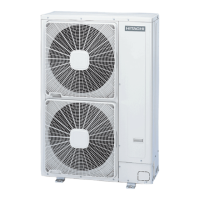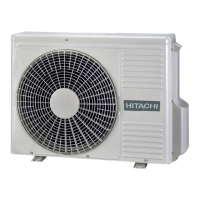What does compressor factor alarm mean in Hitachi RAS-4HRNME-AF?
- NnancypetersonAug 30, 2025
A compressor factor alarm in your Hitachi Air Conditioner indicates that damage to the compressor has occurred 3 times within 6 hours.

What does compressor factor alarm mean in Hitachi RAS-4HRNME-AF?
A compressor factor alarm in your Hitachi Air Conditioner indicates that damage to the compressor has occurred 3 times within 6 hours.
What does hydraulic alarm mean for Hitachi RAS-4HRNME-AF Air Conditioner?
A hydraulic alarm in your Hitachi Air Conditioner indicates that water pressure or water flow is not detected in the hydraulic cycle.
Why my Hitachi RAS-4HRNME-AF shows undervoltage or overvoltage?
Undervoltage or overvoltage issues in your Hitachi Air Conditioner can stem from abnormalities in the outdoor PCB, inverter PCB, DM, or CB.
What causes unit over-temperature limit protection in my Hitachi RAS-4HRNME-AF Air Conditioner?
Unit over-temperature limit protection in your Hitachi Air Conditioner is activated if the water supply temperature is 5ºC more than the maximum water circuit temperature for 20 seconds.
What causes freeze protection by cold water inlet temperature detection in my Hitachi Air Conditioner?
Freeze protection by cold water inlet temperature detection in your Hitachi Air Conditioner is activated if the inlet water temperature is lower than 2 ºC.
What causes Opentherm communication failure in my Hitachi RAS-4HRNME-AF?
Opentherm communication failure in your Hitachi Air Conditioner is caused if there is no Opentherm communication for a continuous period of 1 minute.
What causes RF communication failure in my Hitachi RAS-4HRNME-AF Air Conditioner?
RF communication failure in your Hitachi Air Conditioner happens when there is no communication for 1 hour with one or two RF receivers which are bound to the RF-Bridge.
What causes unit capacity setting error in my Hitachi RAS-4HRNME-AF Air Conditioner?
Unit capacity setting error in your Hitachi Air Conditioner is caused if there is no concordance between indoor outdoor unit capacity.
What causes LCD H-link transmission error in my Hitachi Air Conditioner?
LCD H-link transmission error in your Hitachi Air Conditioner can be caused by no H-LINK communication for a continuous period of 1 minute between Indoor and LCD User control by connection wiring (breaking, wiring error, etc.).
What causes activation of high pressure switch in my Hitachi RAS-4HRNME-AF Air Conditioner?
Activation of the high pressure switch in your Hitachi Air Conditioner is caused when the high pressure (Pd) is higher than 3.0 MPa.
| Brand | Hitachi |
|---|---|
| Model | RAS-4HRNME-AF |
| Category | Air Conditioner |
| Language | English |
Key notices regarding compatibility, specifications, and manual usage.
Explains the heat pump's function, energy efficiency, and features.
Outlines power supply requirements, shutdown procedures, and handling of snow/ice.
Explains functions like 3-minute guard, frost prevention, auto-restart, and defrost cycles.
Guides users on identifying and resolving common operational faults and abnormal sounds.
Lists and illustrates the various components of the outdoor unit.
Shows the flow of refrigerant for cooling and heating, with component identification.
Covers transport, placement, ventilation, and protection from environmental factors.
Details required clearances for single and multiple outdoor unit installations.
Specifies requirements for concrete foundations, anchor bolts, and drainage.
Specifies copper pipe requirements, cleaning, and insulation for piping.
Details how to suspend piping and connect it to outdoor units, including pipe routing.
Covers design charts for piping length, height difference, and pipe size selection.
Outlines the process for charging refrigerant, performing vacuum tests, and pump-down.
Explains the use and connection of the drain boss for water discharge.
Covers checks for electrical data compliance, voltage, impedance, and grounding.
Details wiring connections for outdoor units and the function of DIP switches.
Provides guidelines for wiring between indoor/outdoor units and compliance with local codes.
Specifies recommended minimum wire sizes for power, transmitting, and actuator cables.
Covers checks for unit appearance, installation, electrical connections, and refrigerant circuit.
Guides users through executing and monitoring the test run using the remote control.
Details test run setup via outdoor unit DIP switches for various operational modes.
Explains protection settings for compressor high pressure and fan motor temperature.
Provides a table of alarm codes, origins, details of abnormalities, and main factors.











